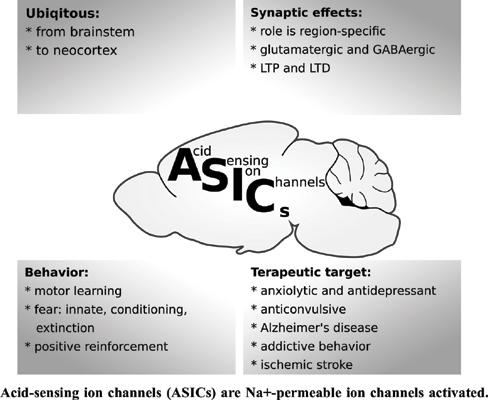Current Neuropharmacology ( IF 4.8 ) Pub Date : 2021-08-31 , DOI: 10.2174/1570159x19666210125151824 Maksim Storozhuk 1 , Andrii Cherninskyi 1 , Oleksandr Maximyuk 1 , Dmytro Isaev 1 , Oleg Krishtal 1

|
Acid-sensing ion channels (ASICs) are Na+-permeable ion channels activated by protons and predominantly expressed in the nervous system. ASICs act as pH sensors leading to neuronal excitation. At least eight different ASIC subunits (including ASIC1a, ASIC1b, ASIC2a, ASIC2b, ASIC3, ASIC4, ASIC5) are encoded by five genes (ASIC1-ASIC5). Functional ASICs assembled in the plasma membrane are homo- or heteromeric trimers. ASIC1a-containing trimers are of particular interest as, in addition to sodium ions, they also conduct calcium ions and thus can trigger or regulate multiple cellular processes. ASICs are widely but differentially expressed in the central and peripheral nervous systems. In the mammalian brain, a majority of neurons express at least one ASIC subunit. Several recent reviews have summarized findings of the role of ASICs in the peripheral nervous system, particularly in nociception and proprioception, and the structure-function relationship of ASICs. However, there is little coverage on recent findings regarding the role of ASICs in the brain. Here we review and discuss evidence regarding the roles of ASICs: (i) as postsynaptic receptors activated by protons coreleased with glutamate at glutamatergic synapses; (ii) as modulators of synaptic transmission at glutamatergic synapses and GABAergic synapses; (iii) in synaptic plasticity, memory and learning; (iv) in some pathologies such as epilepsy, mood disorders and Alzheimer's disease.
中文翻译:

酸感应离子通道:关注大脑中的生理和一些病理作用
酸感应离子通道 (ASIC) 是由质子激活的 Na+ 可渗透离子通道,主要在神经系统中表达。ASIC 充当导致神经元兴奋的 pH 传感器。至少八个不同的 ASIC 亚基(包括 ASIC1a、ASIC1b、ASIC2a、ASIC2b、ASIC3、ASIC4、ASIC5)由五个基因(ASIC1-ASIC5)编码。组装在质膜中的功能性 ASIC 是同聚或异聚三聚体。含有 ASIC1a 的三聚体特别令人感兴趣,因为除了钠离子外,它们还传导钙离子,因此可以触发或调节多个细胞过程。ASIC 在中枢和外周神经系统中广泛但差异表达。在哺乳动物的大脑中,大多数神经元表达至少一个 ASIC 亚基。最近的几篇综述总结了 ASIC 在外周神经系统中的作用,特别是在伤害感受和本体感受中的作用,以及 ASIC 的结构-功能关系。然而,关于 ASIC 在大脑中的作用的最新发现几乎没有报道。在这里,我们回顾和讨论有关 ASIC 作用的证据:(i)作为由谷氨酸能突触处与谷氨酸共同释放的质子激活的突触后受体;(ii) 作为谷氨酸能突触和 GABA 能突触的突触传递调节剂;(iii) 在突触可塑性、记忆和学习方面;(iv) 在某些病症中,例如癫痫、情绪障碍和阿尔茨海默病。关于 ASIC 在大脑中的作用的最新发现几乎没有报道。在这里,我们回顾和讨论有关 ASIC 作用的证据:(i)作为由谷氨酸能突触处与谷氨酸共同释放的质子激活的突触后受体;(ii) 作为谷氨酸能突触和 GABA 能突触的突触传递调节剂;(iii) 在突触可塑性、记忆和学习方面;(iv) 在某些病症中,例如癫痫、情绪障碍和阿尔茨海默病。关于 ASIC 在大脑中的作用的最新发现几乎没有报道。在这里,我们回顾和讨论有关 ASIC 作用的证据:(i)作为由谷氨酸能突触处与谷氨酸共同释放的质子激活的突触后受体;(ii) 作为谷氨酸能突触和 GABA 能突触的突触传递调节剂;(iii) 在突触可塑性、记忆和学习方面;(iv) 在某些病症中,例如癫痫、情绪障碍和阿尔茨海默病。











































 京公网安备 11010802027423号
京公网安备 11010802027423号